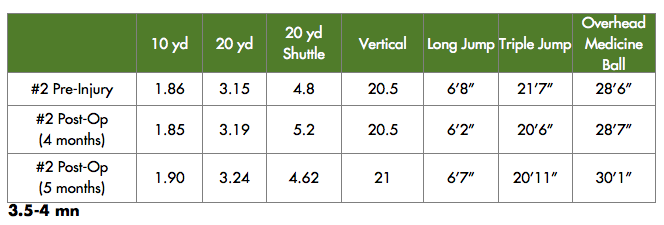This article is in regards to the experience I had with the NHPI during the rehabilitation of one of my ACL repair clients. This client is high school female soccer player who is going on to play soccer at the collegiate level. This client suffered an ACL tear and had straight ACL PTG repair.
As a Physical Therapist who specializes in the rehabilitation of Soccer athletes, I have seen and used numerous "Functional Testing" programs to determine the capabilities of the involved vs. the uninvolved lower extremity of my patients. Where many of these tests are quite helpful they never left me in a position where I felt confident to answer "Yes" when the parent would inevitably ask "is my son/daughter ready to play again". This return to sport capability is something that a therapist should be able to answer, and answer based on objective data. This is where the NHPI (National Human Performance Institute) came in very handy.
The NHPI is a national testing database that complies and compares tests scores from their Official Evaluation Centers across the country. Theses scores come from sites all across the country that are testing athletes on several tests from which the scores are used to determine an athlete’s athletic ability in various areas. These scores are then compared nationally to all other similar athletes. The tests used (40yd dash with 10, 20, 30, and 40 intervals and velocities, standing long jump, standing triple jump, vertical, 5-10-5 shuttle, and overhead medicine ball throw) are fundamental components of almost all sports and very specific in what they tested. These tests are also, to my liking, ones that have been utilized for decades and are easily reproduced with minimal equipment and inter-tester scoring variations.
In my particular case, I was lucky because this patient had tested with the NHPI not too long before she was injured so I had exact goals to shoot for. Even without these previous tests however the comparison to other female soccer players of the same age across the nation would have done the job.
Once her preliminary rehab was done she was advanced into my post-therapy training program around the 6-8 week mark. Here the focused shifted into restoring core strength, total body mobility and flexibility, dynamic balance in all planes, balancing all major muscle groups, and educating the athlete along the way in proper technique during jump/landing training, change of direction, and deceleration. The exercises used in my program are closed chain and Olympic lifting based in nature, and they demand the athlete control his/her entire body while generating as much force as possible and is safe per his/her protocol.
By the 3 month time frame she was well ahead of schedule and was not having difficulty with the standard ACL tests of (single leg squat depth, balance and reach, single leg hop for distance and time, single leg biking, leg press strength comparison, etc…). So with physician approval (4 months post op) she was put through the NHPI tests, and was retested again 1 month later. Her test scores broke down like this,

As you can see by her numbers as of the 5 month post-op testing session she was doing quite well in all areas. As expected it did not take long for her to regain her straight ahead speed or he ability to perform a vertical jump, but as of the 4 month testing her shuttle (lateral change of direction) long jump and triple jump were still noticeably deficient. After just one month more of training however she made very significant improvements. She also noted that she felt her long and triple jump scores were still a little lower due to the fact that she used to land in a much deeper position with poor knee positioning, and that now she was more focused on maintaining good form. A trade off that I think most of us would gladly welcome.
Overall my experience with the NHPI was excellent with an easy to use website, comparison tools to previous tests sessions, grouping comparisons and printable data. They finally allowed me to not only give a confident answer as to whether or not I thought an athlete was able to return to competing at a pre-injury level but I was now able to back it up with data rather than just saying “because they looked good to me when they were running and cutting”. This type of testing and comparing is an invaluable tool for therapists who specialize in athletes because for too long a way to compare athletes and rehabilitation/training protocols on a mass scale has not been available.
Mark Buckingham MS, PT


